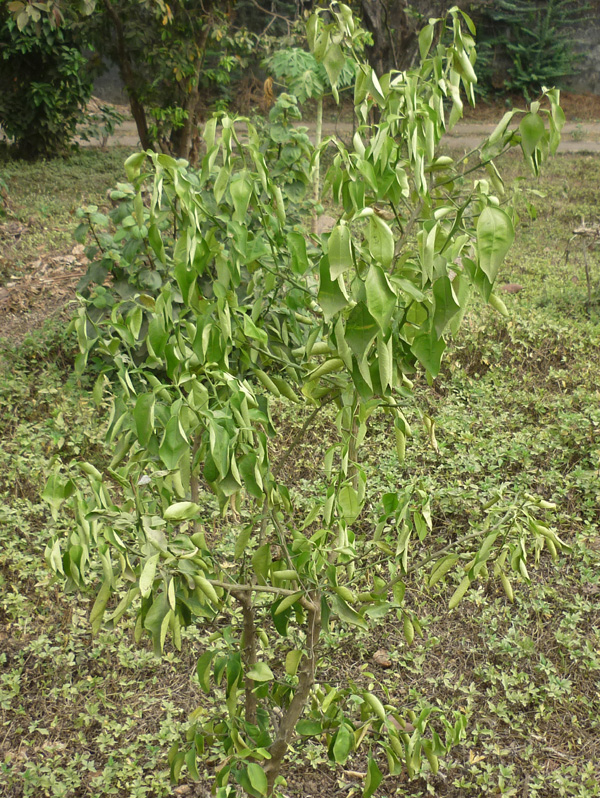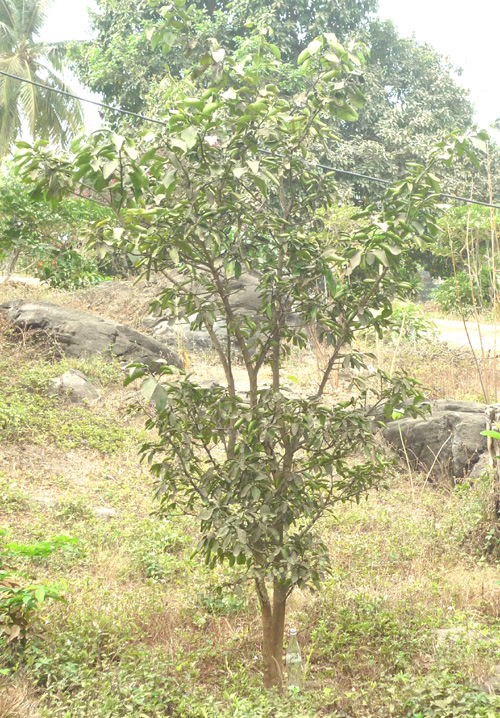 My young citrus trees though are a
long
way from bearing fruit and are showing very definite signs of water
stress in the dry West African harmattan. Leaves have curled and a few
weeks ago I
noticed one or two had
started browning. In past dry seasons some did not survive. A few weeks
ago I began bringing in water, 20
gallons a day, weekdays, for approximately 40 saplings, about
half a gallon per day per plant. It seems like quite a lot to me, but
I'm not sure the plants agree. The browning has been reversed, but
the leaf curl doesn't seem to be going away. The youngest citrus, 1 yr
old, 1 foot
high approx, respond more readily to watering than the older plants. At
about 4 yrs old, 2" trunk base diameter, the signs of water stress are
less obvious; these citrus seem able to survive the dry season without
being watered. Their root systems must be deep enough to be getting
some ground
water. I can find nothing definitive on the internet. One source from
the University of Arizona in the USA estimates that mature citrus trees
need, depending on the season, between 17 and 135 gallons of water per
day. This has to be a joke, right? Forget all the citrus trees and all
the rest of agriculture, in Freetown right now and for most of the dry
season we have people
queuing at public standpipes to get water to drink. My minifarm has
long
been abandoned by the public water utility, so the best I can do is lug
in limited amounts of water to placate my young plants.
My young citrus trees though are a
long
way from bearing fruit and are showing very definite signs of water
stress in the dry West African harmattan. Leaves have curled and a few
weeks ago I
noticed one or two had
started browning. In past dry seasons some did not survive. A few weeks
ago I began bringing in water, 20
gallons a day, weekdays, for approximately 40 saplings, about
half a gallon per day per plant. It seems like quite a lot to me, but
I'm not sure the plants agree. The browning has been reversed, but
the leaf curl doesn't seem to be going away. The youngest citrus, 1 yr
old, 1 foot
high approx, respond more readily to watering than the older plants. At
about 4 yrs old, 2" trunk base diameter, the signs of water stress are
less obvious; these citrus seem able to survive the dry season without
being watered. Their root systems must be deep enough to be getting
some ground
water. I can find nothing definitive on the internet. One source from
the University of Arizona in the USA estimates that mature citrus trees
need, depending on the season, between 17 and 135 gallons of water per
day. This has to be a joke, right? Forget all the citrus trees and all
the rest of agriculture, in Freetown right now and for most of the dry
season we have people
queuing at public standpipes to get water to drink. My minifarm has
long
been abandoned by the public water utility, so the best I can do is lug
in limited amounts of water to placate my young plants.Mature citrus, along with all our other fruit, mango, pawpaw, pear, guava etc do tolerate our five- or six-month dry season pretty well, so some sort of adaptation must have occurred: presumably these trees all have deep roots going down to the water table. The fascinating question though is how much improvement in output would be gained by watering during the dry season? And how much water would be enough to trigger that elusive second harvest, when fruit would not be in season and prices would be much higher? I wish I knew...
Another internet source reports that some citrus need 15 years
before
they begin to bear fruit. 15 years! This is no easy business! I had been counting on five years, but my first citrus plantings are now five
years old and they look a long way from bearing fruit. They are about 8
ft high, but branch canopy diameter is only about 5 ft and
trunk diameter base 2.5 to 3 inches. Should I trim the tops to
encourage branch spread? Does regular watering increase growth and
reduce the years to first fruit? More unknowns. The difficulties of
farming in West Africa become more and more apparent, even though I am
attempting it in the cosy confines of a capital city. I haven't been to
the
agriculture ministry this harmattan to seek advice, but my last visit
there was
far from encouraging. This is no easy business oh! Fifteen years is a
long time to wait on an empty stomach. Would any sensible businessman
undertake an investment where the first returns did not come in for
fifteen years? More and more, the time to first harvest seems to me to
be a crucial determinant of agricultural success, particularly with
traditional West African communal land tenure practices, where longterm
ownership or occupation is not guaranteed.
been counting on five years, but my first citrus plantings are now five
years old and they look a long way from bearing fruit. They are about 8
ft high, but branch canopy diameter is only about 5 ft and
trunk diameter base 2.5 to 3 inches. Should I trim the tops to
encourage branch spread? Does regular watering increase growth and
reduce the years to first fruit? More unknowns. The difficulties of
farming in West Africa become more and more apparent, even though I am
attempting it in the cosy confines of a capital city. I haven't been to
the
agriculture ministry this harmattan to seek advice, but my last visit
there was
far from encouraging. This is no easy business oh! Fifteen years is a
long time to wait on an empty stomach. Would any sensible businessman
undertake an investment where the first returns did not come in for
fifteen years? More and more, the time to first harvest seems to me to
be a crucial determinant of agricultural success, particularly with
traditional West African communal land tenure practices, where longterm
ownership or occupation is not guaranteed.
 been counting on five years, but my first citrus plantings are now five
years old and they look a long way from bearing fruit. They are about 8
ft high, but branch canopy diameter is only about 5 ft and
trunk diameter base 2.5 to 3 inches. Should I trim the tops to
encourage branch spread? Does regular watering increase growth and
reduce the years to first fruit? More unknowns. The difficulties of
farming in West Africa become more and more apparent, even though I am
attempting it in the cosy confines of a capital city. I haven't been to
the
agriculture ministry this harmattan to seek advice, but my last visit
there was
far from encouraging. This is no easy business oh! Fifteen years is a
long time to wait on an empty stomach. Would any sensible businessman
undertake an investment where the first returns did not come in for
fifteen years? More and more, the time to first harvest seems to me to
be a crucial determinant of agricultural success, particularly with
traditional West African communal land tenure practices, where longterm
ownership or occupation is not guaranteed.
been counting on five years, but my first citrus plantings are now five
years old and they look a long way from bearing fruit. They are about 8
ft high, but branch canopy diameter is only about 5 ft and
trunk diameter base 2.5 to 3 inches. Should I trim the tops to
encourage branch spread? Does regular watering increase growth and
reduce the years to first fruit? More unknowns. The difficulties of
farming in West Africa become more and more apparent, even though I am
attempting it in the cosy confines of a capital city. I haven't been to
the
agriculture ministry this harmattan to seek advice, but my last visit
there was
far from encouraging. This is no easy business oh! Fifteen years is a
long time to wait on an empty stomach. Would any sensible businessman
undertake an investment where the first returns did not come in for
fifteen years? More and more, the time to first harvest seems to me to
be a crucial determinant of agricultural success, particularly with
traditional West African communal land tenure practices, where longterm
ownership or occupation is not guaranteed.NEXT(Coming Soon)
PREVIOUS(Another Disaster on the Farm)